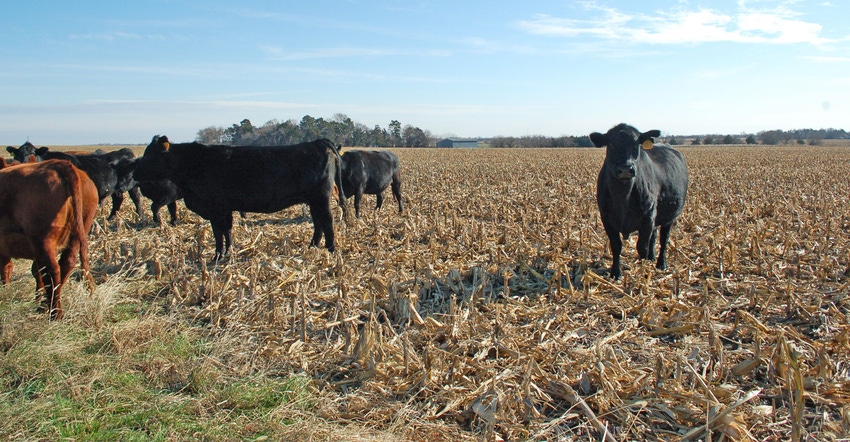
High winds did their damage to Nebraska's corn crop this year. Farmers reported anywhere from 20 to up 70 bushels or more per acre on the ground from high winds before harvest at various locations across the state.
"This year there is even more incentive for farmers to have their residue grazed or baled to get rid of volunteer corn, given the high amounts of downed corn in the state," says Nebraska Extension beef systems specialist Mary Drewnoski. "Grazing is traditionally favored as a method of using residue versus baling, because it leaves much more cover and allows cattle to be selective, so spring calving cows can be maintained without any supplement."
With additional corn on the ground this season, there are risks with grazing and a need for extra management and labor when using cornstalks. Cow-calf pairs can safely graze up to 10 pounds of dropped ear corn and fed 2 pounds of dry matter from distillers grain a day, allowing cows to maintain bodyweight and still put 1 to 1.5 pounds daily gain on the calves.
Because of the extra energy, late weaning is an option. The basic rule of thumb from Drewnoski is that if there is more than 10 bushels per acre of dropped ears on the ground, cattle will need to be adapted and the amount of access restricted until they become accustomed to a corn-based diet. "Unless farmers have a pivot fence, the extra labor of restricted grazing of cornstalks can be prohibitive, especially for producers that have cattle on stalks far from home," she explains.
This year, baling might be the more viable option with the right rake. "Some producers have reported removing 80% of the ears" through this method, Drewnoski says. "This is not usually something I would suggest, given that most of the cover will be removed, increasing the risk of erosion," she explains. "But it may be a way to reduce risk of acidosis and reduce volunteer corn at the same time."
The amount of crop residue increases proportionately with the amount of grain produced in the field, so if you know the yield, you can calculate the amount of residue. "With 200-bushels-per-acre corn and 20-bushels-per-acre ear drop, for example, you would have 5.38 tons of residue including stem, leaf, husk and cob in the field and 1,120 pounds of corn grain," Drewnoski notes. "Assuming that by baling you removed 90% of the residue and 80% of the downed ears, then a bale of residue would be about 9% corn," she says. "If you had 40 bushels per acre in a 200-bushel-per-acre cornfield, then the bale would be about 18% corn."
Bales could be ground to eliminate sorting all together, or you can feed the bales in round bale feeders without grinding. In that case, cattle will be selective, so 20% to 30% waste of mainly stems and cobs would be expected. Drewnoski suggests sampling the bales to formulate a ration, because the amount of corn and residue will vary. "Samples could be obtained during the grinding process or by using a sharp hay core probe," she says. "When sending in the samples for analysis, make sure to have starch analysis marked to find out how much corn is in the bale, because corn is about 70% starch."
You can learn more by contacting Drewnoski at 402-472-6289.
About the Author(s)
You May Also Like






